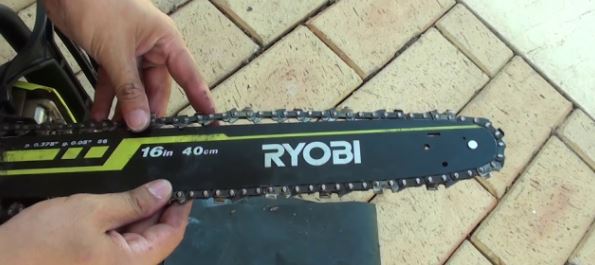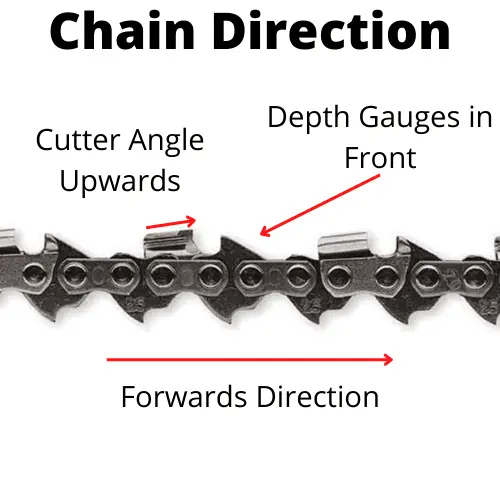To fix a chainsaw chain, first identify the issue: broken links, dull cutters, or improper tension. For broken links, remove damaged parts and reattach the chain with a repair kit. For dull cutters, sharpen using a round file with a guide. For improper tension, adjust using the chainsaw’s tensioner.
Are you in the process of finishing a DIY project, but your chainsaw chain keeps falling off? If that’s the case, you’re probably wondering how to fix a chainsaw chain.
Most of the time, chainsaws that aren’t working are usually not properly tensioned. They may also need proper lubrication. Another possible reason for a chainsaw’s dysfunction is faulty components such as spark plugs, ignition coils, and clogged air filters.
Read on to learn more about why your chainsaw isn’t working and how to fix it.
Table of Contents
Why do Chainsaw Chains Fall Off?
If your chainsaw chains keep falling off, one of the following factors could be the reason:
1. The Chain Is Incorrectly Tensioned
One of the most important things to keep in mind when trying to boost your chainsaw’s longevity is its level of tension.
The extent to which you should have your chainsaw chain tensioned depends on your usage. You must adjust the chain’s tension accordingly if you don’t want it to fall off constantly.
Not only will this improve the effectiveness of your chainsaw cutting, but it will also boost the lifespan of your chainsaw’s bar and motor.
I recommend having your chain tight enough that it won’t fall off the guide bar but loose enough to rotate freely. When you pull against the chain, the drive links should still be engaged.

2. Material is Jammed in the Chain
As you use your chainsaw more and more, this will inevitably lead to materials getting stuck between its links.
For example, if you use your chainsaw to cut firewood, you will likely find twigs and leaves jammed in its chain. These materials can eventually lead to the chain falling off your chainsaw.
Therefore, you should make sure to clean your chainsaw chain regularly. This prevents the build-up of jammed materials from getting to the point where you need the services of a professional to remove them.
3. Incorrect Choice of Lubricant
Since the job of a chainsaw is to cut through hard materials, its operation is inherently high-impact.
Therefore, you must lubricate your chainsaw chain properly to prevent it from falling off or getting damaged. Proper lubrication of a chainsaw includes applying the correct type of lubricant with adequate frequency.
Failing to do so will cause your chainsaw chain to wear down and even deform due to the friction heat. This leads to the chain falling off.
Reasons a Chainsaw Chain Might Not Work
The main issues chainsaw owners face are that their chainsaw isn’t cutting as effectively as they should be or that the chainsaw isn’t starting at all.
Here are the possible reasons for each of these issues:
The Cutting Chain Went Dull
If your chainsaw isn’t performing its cutting duties as well as you’re accustomed to, it’s likely to be a result of the cutting chain going dull. You may need to sharpen or replace it altogether.
Another possible reason is that the chain isn’t tensioned properly. If the chain’s tension is too loose, it won’t slice through wood as it should.
Chainsaw Won’t Start
If your chainsaw refuses to power up, several components may be causing this.
The first things you should check are the spark plug and the ignition coil. The issue may be due to a clogged carburettor or air filter if they seem fine. Another possible culprit is a blown fuse.
How to Tension a Chainsaw Chain
Here’s a step-by-step guide on how to tension your chainsaw chain:
1. Loosen Chainsaw Bar
The first thing you’ll want to do is loosen the bolts that are holding the chainsaw’s bar in place. You can do so using a wrench. You only need to loosen the bolts a little bit.
2. Turn Adjustment Pin
Next, you’ll need to locate your chainsaw’s adjustment pin. This is usually a screw-like component that you’ll likely find on the side of your chainsaw.
Using a screwdriver, turn the adjustment pin clockwise to increase the chain’s tension.
3. Tighten Chainsaw Bar
Once you’ve adjusted the chain to the desired tension, don’t forget to retighten the bolts that secure your chainsaw’s bar.
How to Check the Correct Size Chainsaw Chain
When checking to see if a chainsaw chain is the correct size, there are three factors you need to take into consideration.
These are:
The Pitch
To check the pitch of your chainsaw chain, you need to use a tape measure to get a reading of the distance across three rivets on the chain. You should take this measurement from the center point of the first rivet to that of the third.
The pitch is calculated as half of this measurement.
The Gauge
The gauge of your chainsaw chain is the thickness of its drive links. You won’t need to measure this since the manufacturer typically provides this measurement in the device’s manual.
Drive Links
Another important parameter of a chainsaw chain’s size is its number of drive links. Unlike the gauge, the manufacturer doesn’t provide this information. Therefore, you will have to manually count the number of drive links on your chain.
How to Check the Direction of a Chainsaw Chain
When checking the direction of your chainsaw chain, there are certain components you need to inspect.
The table below includes these components and the position that they should be in.
| Component | Position |
| Drive Links | Should be pointing forward |
| Cutter | Should be pointing forward |
| Guide | Should be immediately in front of the cutter |

Conclusion
For DIY enthusiasts out there, chainsaws are indispensable tools. Knowing how to fix a chainsaw chain is highly important if you’re one of these people.
Before fixing your chainsaw chain, you must first understand the issue and what’s causing it.
Most issues with chainsaws are due to incorrect tension or lubrication and faulty components such as spark plugs, ignition coils, and fuses.
If your chainsaw isn’t cutting through materials as you expect it to, this may also be a result of a dull cutting chain or a cutting chain that’s not the correct size.
